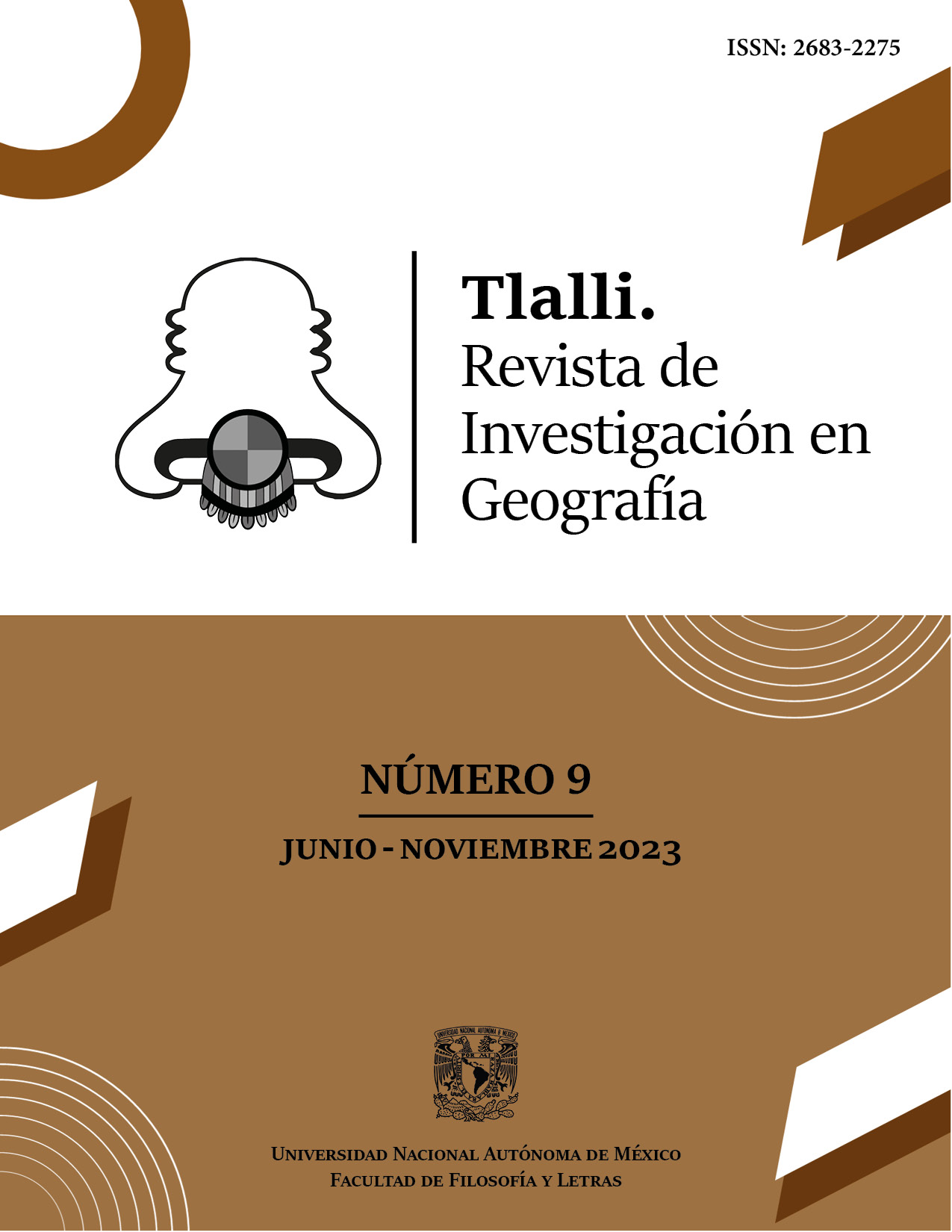Cambio climático, agua subterránea y su enseñanza en la geografía
Main Article Content
Abstract
Inside of scientific literature and in the public debate related how decision makers understand the negative consequences of climate change, greater importance is usually attributed to phenomena as a water scarcity, floods, and droughts, among other adverse effects that have been studied from several disciplines. Precisely, studies from Hydrogeology conclude that water extraction patterns every day are unsustainable because their tendency is to extract larger volumes of non-renewable water on a human time scale, jeopardizing any water security project and making it unfeasible on the long term, the survival of ecosystems associated with hydrogeological dynamics. In contrast, although water is studied in Geography, in this case from subdisciplines such as Hydrogeography, marginal attention tends to be paid to the study of the processes, mechanisms and institutional arrangements that, with a marked territorial dynamic, have favored patterns of extraction of this unsustainable water, the accumulation of rights and inequity in water allocation. In this contribution, a critical reflection is offered that emerges from a set of lessons from the development, presentation and academic debate for groundwater regulation proposal in Mexico published in 2017, concluding the urgent need to modernize the teaching content of hydrological cycle issues and the processes associated with its social transformation under geographic thoughttradition society-nature, as a foundation for updated professional training in Geography in line with challenges imposed by climate change in the currently century.
Article Details

This work is licensed under a Creative Commons Attribution-NonCommercial-NoDerivatives 4.0 International License.
References
Aboites Aguilar, Luis. (1998). El agua de la nación. Una historia política de México (1888-1946). CIESAS.
Arora, Naveen Kumar; Mishra, Isha. (2021). “COP26: More Challenges than Achievements”. Environmental Sustainability, 4, 585–588. https://doi.org/10.1007/s42398-021-00212-7.
Boelens, Rutgerd; Hoogesteger, Jaime; Swyngedouw, Erik; Vos, Jeroen; Wester, Philippus. (2016). “Hydrosocial territories: a political ecology perspective”. Water International, 41(1), 1-14. https://doi.org/10.1080/02508060.2016.1134898.
Carmona, María del Carmen; Carrillo-Rivera, José Joel; Hatch-Kuri, Gonzalo; Huizar-Álvarez, Rafael; Ortega-Guerrero, Marcos Adrián. (2017). Ley del Agua Subterránea: una propuesta. Instituto de Geografía, UNAM.
Carrillo-Rivera, José Joel; Peñuela, Liliana; Huizar-Álvarez, Rafael; Cardona, Antonio; Ortega-Guerrero, Marcos Adrián; Vallejo, Josefina; Hatch-Kuri, Gonzalo. (2017). “Conflictos por el agua subterránea”. En Omar Moncada Maya y Álvaro López López (Coords.) Geografía de México. Una reflexión espacial contemporánea. (Tomo 1) (pp. 151-168). Instituto de Geografía, UNAM.
Carvajal-Ramírez, René. (1967). “Aspectos legales del agua subterránea en México”. Ingeniería Hidráulica en México, 23(3), 249-258.
Comisión Nacional del Agua (conagua). (2018). Estadísticas del Agua en México. semarnat-conagua. https://sina.conagua.gob.mx/publicaciones/EAM_2018.pdf.
Denton Navarrete, Thalía. (2006). El agua en México. Análisis de su régimen jurídico. UNAM.
Diario Oficial de la Federación (DOF). (1948, ene 3). Ley reglamentaria del párrafo quinto del Artículo 27 Constitucional, en materia de Aguas del Subsuelo. Diario Oficial, Órgano del Gobierno Constitucional de los Estados Unidos Mexicano. Tomo clxvi, No. 2. https://www.dof.gob.mx/nota_to_imagen_fs.php?codnota=4443991&fecha=03/01/1948&cod_diario=187625.
Döll, Petra; Mueller Schmied, Hannes; Schuh, Carina; Portmann, Felix T; Eicker, Anette. (2014). “Global-Scale Assessment of Groundwater Depletion and Related Groundwater Abstractions: Combining Hydrological Modeling with Information from Well Observations and Grace Satellites”, Water Resources Research, 50(7), 5698-5720. https://doi.org/10.1002/2014WR015595.
Domínguez, Judith. (2021). La política del agua en México a través de sus instituciones, 1917-2017. El Colegio de México.
Hatch-Kuri, Gonzalo. (2018). “A joint management of transboundary aquifers: from asymmetries to environmental protection”. Frontera Norte, 30(59), 129-154. https://doi.org/10.17428/rfn.v30i59.1130.
Hatch-Kuri, Gonzalo. (2021). “Aguas subterráneas transfronterizas y fracking”. Scripta Nova: Revista Electrónica de Geografía y Ciencias Sociales, 25(1), 169-193. https://doi.org/10.1344/sn2021.25.22625.
Hatch-Kuri, Gonzalo; Schmidt, Samuel; Carrillo-Rivera, José Joel. (2021). “Agua-poder: la gestión del agua subterránea en México y su soslayada dimensión transfronteriza, 1948-2018”. Cuadernos de Trabajo Waterlat-Gobacit, 8(4), 71-94. https://doi.org/10.5281/zenodo.7470039.
Hoogesteger, Jaime. (2018). “The Ostrich Politics of Groundwater Development and Neoliberal Regulation in Mexico”. Water Alternatives, 11(3), 552-571. https://www.water-alternatives.org/index.php/alldoc/articles/vol11/v11issue3/453-a11-3-6/file.
Hoogesteger, Jaime; Wester, Philippus. (2015). “Intensive Groundwater Use and (In)Equity: Processes and Governance Challenges”. Environmental Science & Policy, 51, 117-124. https://doi.org/10.1016/j.envsci.2015.04.004.
Klein, Naomi. (2015). Esto lo cambia todo. El capitalismo contra el clima. Ediciones Culturales Paidós.
Larsimont, Robin; Martín, Facundo. (2022). “Reflections from Latin America on the Hydrosocial Approach: its Use, Abuse, and a Possible Way through the Maze”. En Luttes pour l’eau dans les Amériques: Mésusages, arrangements et changements sociaux [online]. Éditions de l’IHEAL. https://doi.org/10.4000/books.iheal.10157.
Linton, Jamie; Budds, Jessica. (2014). “The Hydrosocial Cycle: Defining and Mobilizing a Relational-Dialectical Approach to Water”. Geoforum, 57, 170-180. https://doi.org/10.1016/j.geoforum.2013.10.008.
Peña, Humerto. (2016). Desafíos de la seguridad hídrica en América Latina y El Caribe. CEPAL.
Poder Legislativo Federal, (1917, feb 5). Constitución Política de los Estados Unidos Mexicanos.
Red del Agua de la UNAM. (2021, 21, 06). “Webinar: Agua subterránea y sequía. Experiencias de la Ley de Aguas Subterráneas de California” [video] Recuperado el 10 de febrero de 2023 de https://www.youtube.com/watch?v=NJz3FMYuXKo.
Ribeiro, Wagner C. (2008). Geografía política da água. Annablume Editora.
Talledos, Edgar; Álvarez, Berenice; Hatch-Kuri, Gonzalo; Rodríguez, Antonio; Velázquez, Juan. (2020) Captura política, grandes concentraciones y control de agua en México. Colegio de Geografía, UNAM. http://ru.atheneadigital.filos.unam.mx/jspui/handle/FFYL_UNAM/2533.
Theesfeld, Insa. (2010). “Institutional challenges for national groundwater governance: Policies and issues”. Groundwater, 48(1), 131-142. https://doi.org/10.1111/j.1745-6584.2009.00624.x.
U.S. Geological Service. (2022). “El Ciclo del Agua – The Water Cycle, Spanish (PNG)” [diagrama]. U.S. Geological Service. Water Science School. Recuperado el 10 de febrero de 2023 de https://www.usgs.gov/media/images/el-ciclo-del-agua-water-cycle-spanish-png.
UN Water (2014). The United Nations World Water Development Report: Water and Energy. UNESCO. Disponible en https://www.unwater.org/publications/un-world-water-development-report-2014.
Walsh, Casey. (2022). “Beyond rules and norms: Heterogeneity, ubiquity, and visibility of groundwaters”. Wiley Interdisciplinary Reviews: Water, 9(4), n/a. https://doi.org/10.1002/wat2.1597.
Wolfe, Mikael. (2014). “Crisis del agua subterránea en México. Dinámica histórica: recursos, lucro y conocimiento en La Laguna, 1930-1970”. HIB: Revista de Historia Iberoamericana, 7(2).
Zektser, Igor; Everett, Lorne G. (2004). Groundwater. Resources of the World and their Use. (Vol. 6). UNESCO.

